
The motto on the car’s number plate caught my eye as I trudged ashore to the immigration office in Gorda Sound: Nature’s Little Secrets. Which caused me to reflect that they might just be the worst kept secrets in history, as the place was absolutely packed with boats and people.
With good reason: The British Virgin Islands are pretty in an arid, scrubby way, and the blue of the water and the sandy beaches are glorious.
Beachfront bars welcome visitors day and night, the sun shines, and there are a wealth of anchorages and moorings within a few hours’ sail in most directions. It’s a highly attractive picture, if you’re on holiday.
A Cruising Destination?
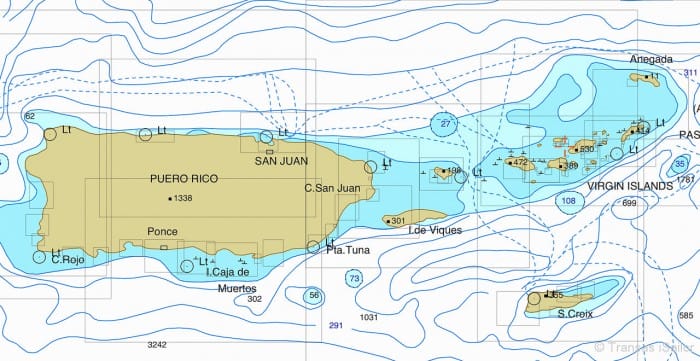
But we’re not on holiday, at least not in the sense that we’re taking a break from jobs in cold, damp Britain, to sniff the salt air and feel the trade winds and dream of a life like this. This is our life, and we see things rather differently.
The busy waters, crowded anchorages, lunatic boat handling, and the complete absence of any sort of respectful behaviour on the part of the big power boats that abound, drove us mad, and we couldn’t wait to move on.
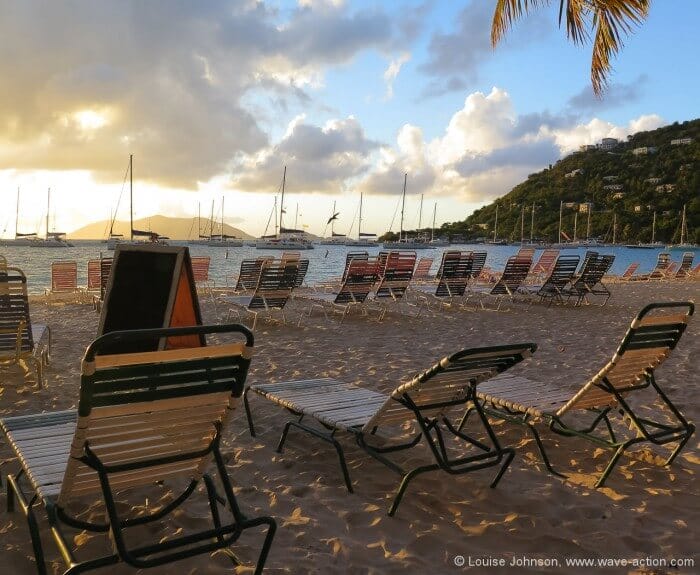
Which may seem like a harsh judgment until you stop to think just who these islands are aimed at as a destination:
Dreamers, hoping one day to make the move aboard and cast off the lines, trying out ‘the life’ to see how they like it—selling the idea to their families, grabbing a few weeks of sun, sand, snorkelling and a frisson of adventure—before returning to perhaps a humdrum nine-to-five existence in their life at home.
Or older friends and family groups looking for just enough sailing, more than enough sun and islands, and a place where the rum is cheap and there’s always a table available.
If we fitted either of these categories I’m sure that we’d have absolutely loved the place. Forty years ago I know I’d have loved the place!

It’s just that we’ve moved on, and maybe that’s simply because we’ve been spoiled by all of the rawer, remoter, more challenging places that we’ve seen, by comparison with which to us this all seems very tame and packaged.
And we love peace and quiet, which is a very rare commodity in these islands.
There are lovely spots to be found if you try harder, though, and there were a few we really enjoyed, but for the most part the BVIs are aimed at a different market to people like ourselves.
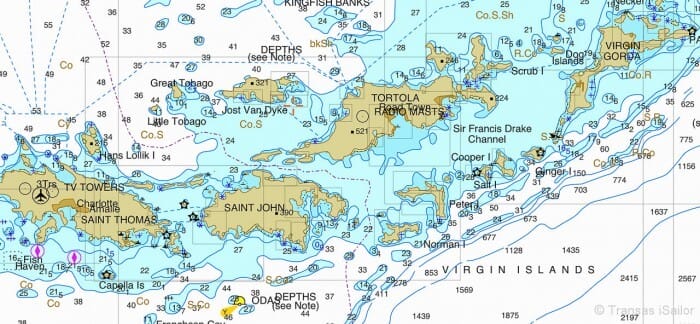
However, if such places didn’t exist, we’d have to invent them—they serve the really valuable function of encouraging people to go further with their cruising ambitions…and that’s no bad thing.
The US Virgin Islands
We moved across to St John in the USVIs hopeful that we’d find some peace and respite from the mad helmsmen who hurtled through the anchorages in the BVIs.
Much of the island is a National Park, and the authorities are making solid efforts to restore the waters around the islands to a pristine state. As a result, anchoring is not permitted along the southern shore of St John, although there are moorings in most of the bays.
Along the north coast, there are also a multitude of moorings available, and you’re actively encouraged to use them and avoid anchoring unless all of the moorings are already taken.
But after a night of the hard plastic buoy banging against our tin hull due to the fluky winds and quirky currents, the appeal of the moorings soon palled, and we made our way to St Thomas.
Charlotte Amalie is a substantial place that seems to cater mainly to cruise ships. There were seven of them in the one day we were there, and the roads were flooded with taxis heading in every direction.
Looking around us there were a good forty or fifty cruising yachts at anchor, making us think that there must be some kind of cruisers’ hangout nearby. But if there was, we never found it, and we were amazed that there was so little on offer to encourage more yachts to visit.
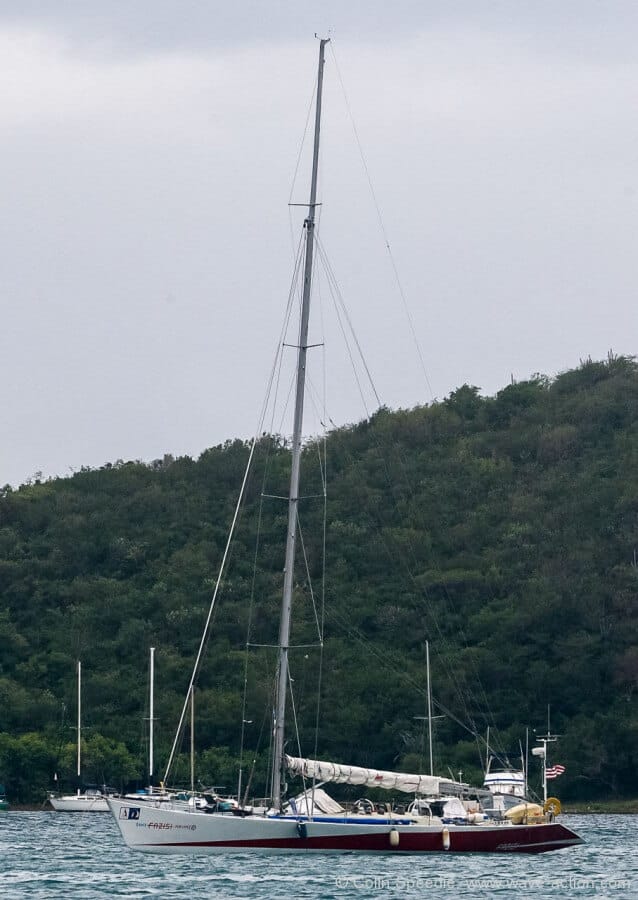
It was interesting to see a real ocean greyhound amongst all of the cruising boats in the form of the ocean racer Fazisi, now under the US flag.
Originally designed and built in Russia to race as their first ever entry in the 1989-90 Whitbread Round the World Race, co-skippered by US Whitbread veteran Skip Novak, she suffered from disputes over her IOR rating, lack of funds, and a largely amateur crew, which was a great shame as she demonstrated some really innovative thinking and terrific speed potential.
With her ski ramp bow, low freeboard and towering rig, she still looks the part, and appears to be well kept—one old race boat that certainly hasn’t gone off to die.
The Spanish Virgin Islands

We’d heard so many good things about the so-called Spanish Virgin Islands of Culebra and Vieques, that we were in a hurry to get there.
The grapevine spoke of peaceful anchorages and low key haunts for the liveaboard set, and it was a real pleasure to find out that this was indeed true.
Knowing that a solid spell of wet and windy weather was on its way, we hightailed it out of St Thomas to Culebra, arriving just before dark to anchor in a small bay in the mangroves just inside the entrance to Ensenada Honda.
At 3 a.m. (of course) we were reminded why anchoring in mangroves isn’t always the wisest move, at least if you haven’t put up your mosquito net, as the cabin was filled with the unwelcome whine of those accursed little beasts.
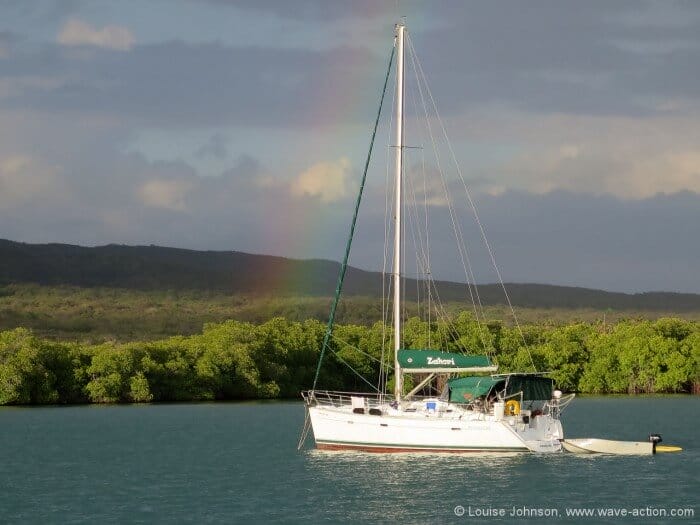
Moving up the harbour to anchor off the town, we settled into a pleasant regime of walks, catching up with friends and making new ones—the real pleasures of this way of life.
Culebra has a small cruising community who live there year round, who told me that things were getting a mite too crowded for their tastes these days, what with the place becoming more popular.
After the BVIs I thought that a little perspective might have helped in this case, but it is, of course, all relative. Fifty boats at anchor in Ensenada Honda might not seem much to these new eyes, but to those who knew it when there were only five, it must now look like The Baths.
Vieques, to the south, was even quieter, and the first night we spent at anchor in lonely Ensenada Honda (another one) we were the only boat there.
This may be at least partly because the eastern end of the island is basically off limits, due to its past use for target practice by the US Navy. There are apparently thousands of unexploded pieces of ordnance lying all over the place, including under the waters we were in, so I very gently lowered the anchor, just in case.
We awoke to loud birdsong, and emerged from the cabin to find the boat completely festooned with lovely little Caribbean martins, a welcome way to start the day.
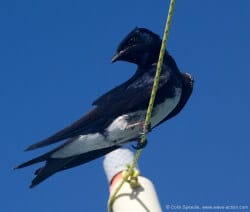
We enjoyed a few nights of total peace and solitude in Ensenada Honda, which was good for re-charging our batteries before moving along the coast to Sun Bay and the town of Esperanza, both good anchorages in the conditions that we had.
Like Culebra, Esperanza has become something of a cruisers’ favourite, but it remains very low key, with a row of waterfront bars and restaurants, and a couple of basic shops—a suitable place to stop before making the crossing to Puerto Rico, where we had a week booked in the marina at Puerto Del Rey.
Puerto Rico
Marinas are not our normal or preferred habitat, but do come in useful for allowing us to catch up, stock up or go travelling ashore.
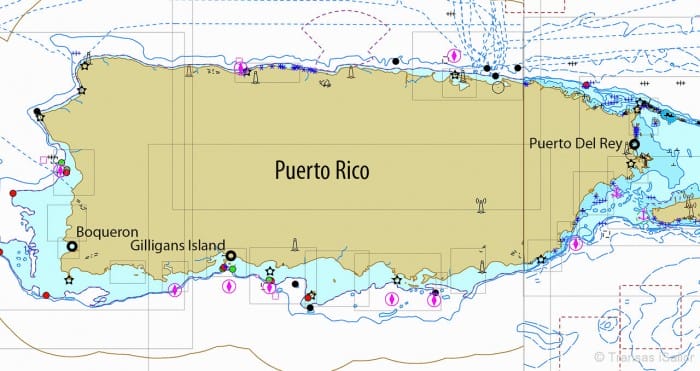
Puerto Del Rey is a huge modern complex, well-sheltered and serviced, ideal for those purposes. This stop doesn’t figure widely in cruisers’ chat rooms, but we’re more than a little surprised, as it has a lot to offer: a mountainous interior, good hiking, history in old San Juan, some great anchorages along the south coast and wonderful, friendly people. We loved it.

After a week of R & R, and with the weather still not playing ball, we shelved our original plan to depart for the Bahamas around the north coast of Puerto Rico, and instead used the fresh conditions to explore the southern shore, charging through the alarmingly named Boca del Infierno into the sheltered Bahia de Jobos for a quiet evening anchorage.
The following day we slipped around into Salinas, another cruisers’ haunt, anchoring just outside the lagoon in the shallows with our centreboard and rudder up. That evening Lou was treated when a manatee surfaced right beside the boat, her first, and a long awaited one.
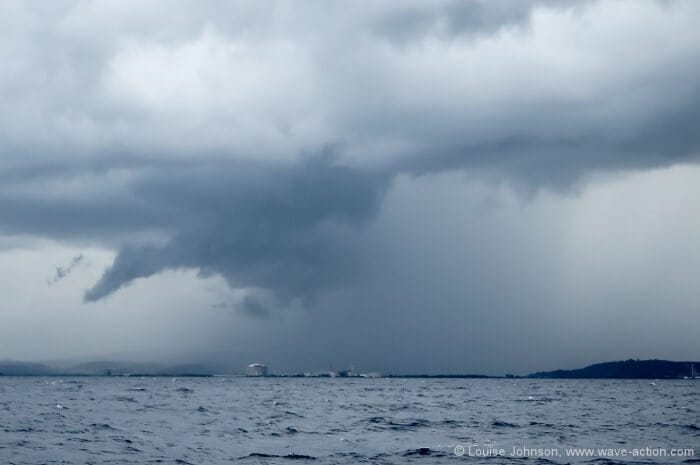
Time To Go…
By now the weather was decidedly off colour, with the sky solidly black over the mountains and a stiff following wind for us to make tracks up the coast. With thunderstorms visible and audible down to the shore and even a couple of funnel clouds forming too close for comfort, we just kept the pedal down, passing the historic town of Ponce to enter a lovely protected anchorage inside Gilligan’s Island, which we shared with only two other cruising boats, both waiting for a lull in the weather to continue the slog east.
That evening the weather finally cleared, and we enjoyed a beautiful sunset in a lovely location, and noted down yet another mark of approval for Puerto Rico.

Moving round to Boqueron was just a tactical shift to be ready to make the hop to the Bahamas. By now we were well behind time to be there, after technical issues with our watermaker and other glitches.
Boqueron was a disappointment, though, noisy and with mad motorboat drivers charging around at high speed (do they have any other speed?), one of whom very nearly ran me over while I was in our dinghy, so we moved to anchor off the small, friendly marina around the corner at Puerto Real, where we sat at anchor with two other northbound boats, waiting for the perfect weather window—which wasn’t long in coming.

Hi Colin
Not surprised that Boqueron was full of speedboat drivers— Puerto Ricans do love their motors. When I was in Peace Corps training many decades ago my buddy from the family I was staying with bought a couple bottles of cheap rum and used it to fuel a trip for us in a farm stake bed truck to the beach party celebrating the announcement of future “development” at Boqueron. Everything changes.
PS If you are still in the Bahamas, pop over to Eleuthra. Nice little towns and anchorages with only a couple of boats in them.
Hi Richard
they do love their motors – at the weekends there were classic cars all over the place. But the speed boats…..
Too late for Eleuthera I’m afraid – we’ll have to save that for next time.
Best wishes
Colin
Hi Colin, Fun report that brings back memories. A bit depressing as it pertains to the VIs as they sound little changed or worse. (And why we spent the next couple of years in Central America/ the NW Carib.) I might have (did actually) say much the same things 10 years ago. You mirrored our stops and we also were very pleasantly surprised by the terrific cruising grounds on the S side of PR. Luperon was quite the watering hole back then that also allowed for easy exploration of the DR: a quite interesting country.
Thanks for the report. Dick Stevenson, s/v Alchemy
Hi Dick
well, places like that are a little like leaks – they don’t get better, so maybe it’s just best to treat them as sacrificial places so that the more remote spots remain tranquil.
Missed out on the DR, but heard very mixed reports – some loved it, others, well, differed!
Best wishes
Colin
Hi Colin,
Great article, but sorry about the first half and glad you had better results in the second half the article. We bolted the E. Carib not long after arriving from Europe. We found life much nicer in the W. Carib where it seemed to us that the cruisers were real and friendly and the locals amazing. About 200 boats at any one time in the San Blas islands, most in the western half. We spent weeks never seeing another sail boat in the uncharted eastern Islands.
Maybe it will stay this way because it is an upwind sail to get back to East Coast of USA. Also hard to get work done on boats in Panama, not what I would call expert. And don’t forget 8 sailboats were lost on the poorly charted reefs of the San Blas this last sailing season. For the inexperienced sailor it can be a tough place to hangout.
Thanks for the great article.
Cheers
Steve and Tracy
Hi Steve and Tracy,
Really? Eight boats lost on the reefs in the San Blas. That is amazing in this day and age. Ten years ago in the NW Carib I was clear that the charts, electronic and paper, were merely suggestions of what we might find and it was the only time we regularly used rat lines for piloting.
About services in Panama, I believe that Lyman Morse has a yard doing work in Panama situated on the Carb side, but I do not know the details or access questions. They are a premier US boatyard which probably means good to excellent work, but at a premium price.
Do you plan to got through the canal or make the push into the NW Carib and then on to the US? There is at least one decent boatyard in Honduras.
My best, Dick Stevenson, s/v Alchemy
Hi Dick,
Yup, 8 sailboats were lost on the reefs of the San Blas last winter. It was very sad to not only see these boats on a reef many of them well kept but it was really hard and sad to meet to owners and hear their story. All 8 boats I believe went on the reefs after dark and coming from a passage from somewhere else. Sad to say people just do not want to heave to anymore. When asked the reply was somewhat like this,”I guess we should of hove to, we thought about it but decided to go for it and get some sleep”. By the way 6 or 7 of those lost boats were lost in one weeks time. We had had some of the worst Christmas winds ever off of Columbia driving a large short swell train into all of the Caribbean Panama coast. Even Kelly Slater flew into Bocus Del Toro to surf the 15 foot surf.
If I have my numbers right, I think half of the lost boats were American owned and half were French. I know there was one large hippi back packer boat lost and I have no idea how there were not more of those lost as they are a sham and a major disaster waiting to happen. Thank god Columbia is putting strict safety laws on the hippi back packer boats stopping the trade in young travelers between Columbia and Panama. But now many of these poorly kept boats just hang out in the San Blas Islands and getting into trouble with the cruising community and the San Blas Indians also.
Sailing in the San Blas is nowhere as difficult as sailing in the S. Pacific Island chains. Visual sightings of reefs are easy in the w. Carib even on all but the darkest of cloudy days but I guess that does not help at night. The Kuna Indians have a law that no boat of any type can travel at night through the San Blas. But they have no way of enforcing it so it is just a law.
As for us we are headed through the canal next year and slowly making our way to the Caroline Islands and the jungle rivers of Borneo. The Boreal 44 has been just an incredible machine, in 40 years of sailing fine blue water boats we have never had a boat that sails as well and as seaworthy as the Boreal.
Best
Steve and Tracy
Hi Steve & Tracy,
Thanks for the report, appalling as it is. A good argument not to do night entries even in this day and age of electronic helpers. I am very sorry to hear that the San Blas Indian community are having to deal with those of our sailing community who are disrespectful, negligent and law breaking. That is a shame. I am glad you love your Boreal. Everyone should be in love with their boat and with Boreal, there appears to be a lot to love.
My best, Dick Stevenson, s/v Alchemy
Hi Dick and Steve & Tracy
I’m not entirely surprised about the loss of boats in the San Blas, as I’m sure we’d see more of the same elsewhere if those places weren’t so easy. Electronic charting has a lot to do with it, I think, in that people believe everything they can see on that little screen, and from y own experience many charts in out of the way places are hundreds of metres out.
Lou and I never enter places after dark if we can at all avoid it – we simply slow down well offshore and take our time, to ensure we arrive at dawn. It’s a simple, no downside philosophy and has never failed us.
And as for the hippie boats, well we met a smattering of those throughout the Caribbean, and just as elsewhere soon lost patience with their freeloading, help yourself attitudes. We absolutely love to see young people sailing old boats around, but the mindset of a significant minority of them leaves an awful lot to be desired.
Best wishes to you all
Colin
Colin,
So glad you mentioned the young people out and sailing the world. What a great group of new cruisers we have met. Be it young families or two or three adventurous young men who worked their fingers to the bone building a travel fund so they could explore the world by sail boat. All of them are friendly and are like a sponge to learn about the proper way to sail. We point them to AAC often as it is just a great place for the serious young sailor to get ideas. Unfortunate that most are European and less and less N. American young people out and about. Guess the need to finish uni and get a job is just too important if they are going to have a sound life in N. America. I am guessing that about 40% of the cruisers that we meet are under 35 years old. That is a good number in my mind and most do just great even with small older boats that are kept up as best can be expected with the kitty they have.
And you are right that we do see dreams shattered and boats turning green with mold and moss parked in every stink hole one can imagine. I think it has always been that way even in the days of the great sailing ships. Some just did not make it for whatever reason and had a slow death of rot in some harbor far away from their home port.
Cheers
Steve
Electronic helpers are deceptive to the thoughtless cruiser, who may erroneously assume that a chartplotter wants to survive a drowning. Their misuse facilitates basic errors in seamanship, such as “approaching hard bits; wait for optimal conditions and light”. I don’t think it’s surprising that we are seeing more “electron-abetted”, avoidable incidents these days. We cede too much trust and authority to them. If I see a coral head at 0930h making for a break in the reef, it’s not because I have the plotter on.
Colin – I believe one of the reasons you saw fewer cruisers in the Spanish Virgin Islands is most of the charter companies in the USVI and BVI restrict their customers from traveling there. The last time I was sailing in that area (2 years ago) I heard rumblings of a possible shift in this policy. I really enjoyed sailing and visiting the SVI, so I hope if those policies do change (if they haven’t started already) that it doesn’t effect the peacefulness of the area too much.
Robert